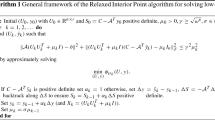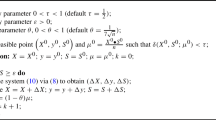Abstract
Given a nonnegative, symmetric matrix of weights, H, we study the problem of finding an Hermitian, positive semidefinite matrix which is closest to a given Hermitian matrix, A, with respect to the weighting H. This extends the notion of exact matrix completion problems in that, H ij =0 corresponds to the element A ij being unspecified (free), while H ij large in absolute value corresponds to the element A ij being approximately specified (fixed).
We present optimality conditions, duality theory, and two primal-dual interior-point algorithms. Because of sparsity considerations, the dual-step-first algorithm is more efficient for a large number of free elements, while the primal-step-first algorithm is more efficient for a large number of fixed elements.
Included are numerical tests that illustrate the efficiency and robustness of the algorithms
Similar content being viewed by others
References
F. Alizadeh, J.-P.A. Haeberly, and M.L. Overton, “Primal-dual interior-point methods for semidefinite programming: convergence rates, stability and numerical results,” Technical Report, Courant Institute of Mathematical Sciences, 1996, NYU Computer Science Dept. Technical Report 721.
W.W. Barrett, C.R. Johnson, and R. Loewy, “The real positive definite completion problem: cycle completability,” Memoirs of the American Mathematical Society, p. 71, 1996.
J.M. Borwein and H. Wolkowicz, “A simple constraint qualification in infinite dimensional programming,” Mathematical Programming, vol. 35, pp. 83-96, 1986.
J.M. Borwein and A. Lewis, “Partially finite convex programming, Part I, duality theory,” Mathematical Programming, vol. 57, pp. 15-48, 1992.
S. Boyd, L. El Ghaoui, E. Feron, and V. Balakrishnan, “Linear matrix inequalities in system and control theory,” Studies in Applied Mathematics, SIAM: Philadelphia, PA, vol. 15, June 1994.
H. Dym and I. Gohberg, “Extensions of band matrices with band inverses,” Linear Algebra and Its Applications, vol. 36, pp. 1-24, 1981.
W. Glunt, T. Hayden, C.R. Johnson, and P. Tarazaga, “Maximum determinant completions,” Technical Report, Dept. of Mathematics, College of William and Mary, Williamsburg, VA, 1994.
B. Grone, C. Johnson, E. Marques De Sa, and H. Wolkowicz, “Positive definite completions of partial Hermitian matrices,” Linear Algebra and Its Applications, vol. 58, pp. 109-124, 1984.
C. Helmberg, F. Rendl, R.J. Vanderbei, and H. Wolkowicz, “An interior point method for semidefinite programming,” SIAM Journal on Optimization, pp. 342-361, 1996. URL: ftp://orion.uwaterloo.ca/pub/henry/reports/sdp.ps.gz.
R.A. Horn and C.R. Johnson, Matrix Analysis, Cambridge University Press: New York, 1985.
C.R. Johnson and B. Kroschel, “Principal submatrices, geometric multiplicities, and structured eigenvectors,” SIAM Journal on Matrix Analysis and Applications, vol. 16, pp. 1004-1012, 1995.
C.R. Johnson and P. Tarazaga, “Approximate semidefinite matrices in a subspace,” Technical Report, Dept. of Mathematics, College of William and Mary, Williamsburg, VA, 1995, to appear in SIMAX.
M. Kojima, M. Shida, and S. Shindoh, “Reduction of monotone linear complementarity problems over cones to linear programs over cones,” Technical Report, Dept. of Information Sciences, Tokyo Institute of Technology, Tokyo, Japan, 1995.
M. Kojima, S. Shindoh, and S. Hara, “Interior-point methods for the monotone semidefinite linear complementarity problem in symmetric matrices,” SIAM J. Optim., vol. 7, no.1, pp. 86-125, 1997.
S. Kruk, M. Muramatsu, F. Rendl, R.J. Vanderbei, and H. Wolkowicz, “The Gauss-Newton direction in linear and semidefinite programming,” Technical Report in progress, University of Waterloo, Waterloo, Canada, 1997.
D.G. Luenberger, Optimization by Vector Space Methods, John Wiley, 1969.
J.R. Magnus and H. Neudecker, Matrix Differential Calculus, Wiley: New York, NY, 1988.
C.A. Micchelli, P.W. Smith, J. Swetits, and J.D.Ward, “Constrained l p approximation,” Journal of Constructive Approximation, vol. 1, pp. 93-102, 1985.
S. Mizuno, M.J. Todd, and Y. Ye, “On adaptive-step primal-dual interior-point algorithms for linear programming,” Mathematics of Operations Research, vol. 18, no.4, pp. 964-981, 1994.
J.J. Moreau, “Décomposition orthogonale d'un espace hilbertien selon deux co{ie190-01}es mutuellement polaires,” C.R. Acad. Sci. Paris, vol. 255, pp. 238-240, 1962.
Y.E. Nesterov and A.S. Nemirovsky, Interior Point Polynomial Algorithms in Convex Programming: Theory and Algorithms, SIAM Publications: SIAM, Philadelphia, USA, 1994.
M.L. Overton, “Large-scale optimization of eigenvalues,” SIAM J. Optimization, vol. 2, pp. 88-120, 1992.
P.W. Smith and H. Wolkowicz, “A nonlinear equation for linear programming,” Mathematical Programming, vol. 34, pp. 235-238, 1986.
Author information
Authors and Affiliations
Rights and permissions
About this article
Cite this article
Johnson, C.R., Kroschel, B. & Wolkowicz, H. An Interior-Point Method for Approximate Positive Semidefinite Completions. Computational Optimization and Applications 9, 175–190 (1998). https://doi.org/10.1023/A:1018363021404
Issue Date:
DOI: https://doi.org/10.1023/A:1018363021404




